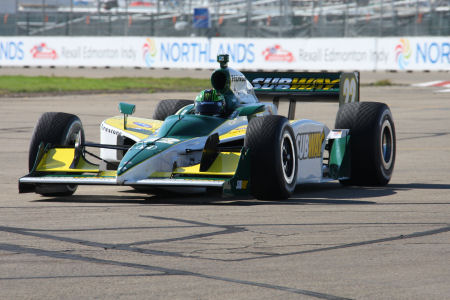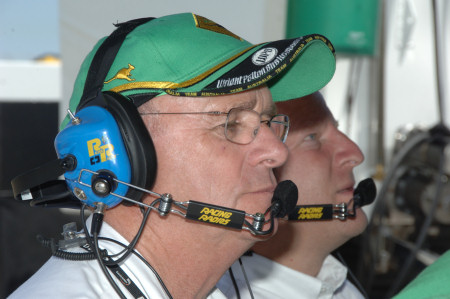The Way It Is/ Looking for a new direction
by Gordon Kirby Praise be, we've survived another Red Neck High Holy Days at Daytona, that continuing grand celebration of fossil fuel-burning, Goodyear tire-torturing, restrictor plate-style block ’em and wreck ’em racing. Until the rain-shortened finish this year's 51st Daytona 500 was quite a show, providing plenty of fodder for NASCAR's ongoing soap opera with the series most popular driver forced to ’fess up that he wasn't entirely an innocent bystander. But in the bigger picture this year's Sprint Cup season-opener was a classic example of how contemporary spec car and performance-restricted racing has resulted in an abrogation of what motor racing once was at its purist best.
Praise be, we've survived another Red Neck High Holy Days at Daytona, that continuing grand celebration of fossil fuel-burning, Goodyear tire-torturing, restrictor plate-style block ’em and wreck ’em racing. Until the rain-shortened finish this year's 51st Daytona 500 was quite a show, providing plenty of fodder for NASCAR's ongoing soap opera with the series most popular driver forced to ’fess up that he wasn't entirely an innocent bystander. But in the bigger picture this year's Sprint Cup season-opener was a classic example of how contemporary spec car and performance-restricted racing has resulted in an abrogation of what motor racing once was at its purist best.
One upon a time, even in stock car racing, blocking was verboten. Only the rudest, crudest drivers considered or practiced the technique and for most of the sport's history it was entirely unacceptable. For great drivers like Juan-Manuel Fangio, Stirling Moss, Jim Clark and Dan Gurney in Formula 1 and sports car racing through A.J. Foyt, Parnelli Jones, Al Unser Sr. and Mario Andretti aboard USAC dirt track cars and Indy cars, blocking was considered immoral. You outraced and outcornered the other guy and might occasionally put a wheel inside his. But blocking or touching the other car was considered highly unsportsmanlike. It was also extremely dangerous with death or serious injury a likely result.
In more recent times guys like Rick Mears and Al Unser Jr. showed us the right way to race--aggressively but cleanly without squeezing or blocking. But times changed as superstars like Ayrton Senna, Nigel Mansell and Michael Schumacher brought a new ethic to F1. Mansell helped extend the blight to Indy car racing when he left F1 for CART in 1993 and ’94 and these days it seems everyone does it all the time in most categories of racing. In NASCAR, and restrictor plate racing in particular, blocking and mirror-driving are stock-in-trade.
At the same time the spec car plague has overtaken the sport and with everyone rushing around in NASCAR-like packs struggling to find a performance advantage, blocking and mirror-driving have become intertwined with the sport. Everyone--the guys who work on the cars, the fans, the drivers--hate spec cars, but the CoT and its brethren are here to stay because the sport has lost any sense of what it once was and lacks completely for technical leadership.
Lou Marzelli, the proprietor of my local deli, isn't a race fan, but he watched this year's Daytona 500 on TV. "What's with those cars?" Lou asked. "They look like some kind of subcompact. They're all narrow and tall, rather than wide and long like a race car should be."

© Walker Racing
I've railed on about this for some time and it was nice to chat last week with Derrick Walker about his ideas for creating a real green or technological challenge for the sport. Walker is a veteran team owner and former crew chief, of course, although he's struggling to stay in business this year. Walker ran his team in Champ Car in 2007 as Team Australia with Will Power and Simon Pagenaud driving, but he fell-out with colorful Team Oz man Craig Gore who moved on to KV Racing last year but has since departed the sport and is engaged in a squabble with the Australian tax authorities.
Walker ran a trio of Atlantic cars last year for Nigel Mansell's two sons and Canadian Kevin Lacroix. He also fielded an IRL car for Paul Tracy on a one-off basis at Edmonton where Tracy finished a rousing fourth. But neither Walker nor Tracy have any work or serious sponsorship this year.
"My chance of pulling something off for one of the junior series is 50/50," Walker remarked. "I've kept my core group employed. We've just been weathering the storm as best we can and trying to sell. I'm still recovering from the Team Australia thing in 2007, but we've got a good basic operation here and I'm hopeful we can continue on."
Between sales pitches Walker has been contemplating where the sport is going in the longterm and is developing a plan for a proper ’green challenge' formula beyond the sport's mainstream.
"When you've got little to do," Walker joked, "it gives you time to doodle on exercises like this."
Walker's premise is that racing is a backward-looking 20th century sport that must change its ways.
"Unless racing becomes relevant it's got a very limited future," Walker observed. "In the big picture, today's racing technology is already obsolete. It's a dinosaur and it can't sustain itself. And guess what? The manufacturers are racing in another direction right now. So let's give them a platform where they can play."
Walker would like to see a single big event established for alternately-powered racing machines.

© Walker Racing
"You would want to try to not get into the detail of how you race an electric car against a hydrogen car and so on. Although ultimately, that would have to be addressed. But to start with you would try not to get bogged-down in the rules and the regs.
"The idea would be to establish a concept and an event at a place in the country that people would come to in oreder to sell any kind of green technology whether it's windmill fans or solar panels. It would be an event, a gathering downtown that a city could benefit from, a convention of all these technologies ’round the theme of ’The Technology Grand Prix'."
Walker would love to see the formula embrace not only a wide range of engines or power sources but also different chassis and aerodynamic configurations.
"There are two parts to it," Walker remarked. "One is the power source and the other one is let's get back to creativity in the design of the cars. Let people build some weird-looking cars again. Let's not say that everyone's got to be in a Dallara and everybody should be the same. Let's get back to the days when you had everything from the Penske-Mercedes to the Hurtubise Special.
"The manufacturers are building production cars, not race cars. So I would say make it an open-topped car, but let them cover the wheels. Make it an open, sports car type of machine and try to attract as many manufacturers, or crackpots, or investors, from around the world that would see this is the big prize for the best new technology. Put up a big chunk of prize money and create an event around it. It would be a technology race, not man against man."
Waker agrees with me that all of the existing auto racing sanctioning bodies are too hidebound to embrace the wide thinking required to write the rules for such a visionary form of motor sport.
"The rules need to be written by independent experts not affiliated necessarily to racing," Walker said. "When it comes to presenting your car in the pitlane to go racing there are safety concerns to be met and measuring the basic dimensions of the cars. As long as the cars are safe you should create as much freedom in the rules as possible as far as all aspects of the car, not just the engine."
Walker believes that five or ten years down the road the formula he's talking about would be adopted as a sub-category competing in the Indy 500.
"Ultimately, there should be a place for that technology at the Indianapolis 500," Walker commented. "It would be great to see the category folded into the Indy 500 so that there was a race within a race for alternate cars. You could create a category that becomes acceptable in the Indy 500 and blends that technology into the real world of racing.
"It will take a while to see what technology takes the lead but the idea is to create an open entrepreneurial arena to accomodate biofuels, or half-electric hybrids, or whatever. The aim would be to produce as much variety as possible because that would make it an interesting event to the wider world."
Writing the rules and determining the equivalency formula required to make Walker's concept a reality would not be an easy task.
"There has to be an equivalency, some way to formulate the different power sources against each other," Walker said. "How you would write those rules would not be easy."
Walker imagines getting the federal and state governments involved to help fund his idea.
"You would want to go to Washington and make appeals for federal dollars to the Department of Energy and also to the state and city where you were going to stage the event," he said.
All this is fun to contemplate but there's a downside to having true ’green' racing without any of those dreaded fossil fuel-burning engines. If Walker's theoretical formula is all about hydrogen fuel cell or electrically-powered cars it will lack the great aural experience of motor racing.
"It could be the biggest four hours of boredom a guy could get," Walker remarked. "It may be totally impractical in that sense."
Could racing thrive without the noise generated by the internal combustion engine? And can racing in America become a technologically-driven gentleman's sport rather than a red neck block ’em and crash ’em show? Those are just two of many questions to be answered if racing ever is to make a great leap forward like Walker and some of us hope for.
Auto Racing ~ Gordon Kirby
Copyright 2009 ~ All Rights Reserved
Copyright 2009 ~ All Rights Reserved
Top of Page